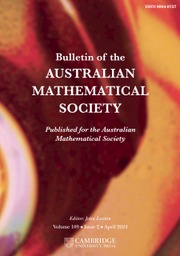No CrossRef data available.
Article contents
THREE ALGORITHMIC APPROACHES TO THE GENERAL POSITION PROBLEM
Part of:
Graph theory
Published online by Cambridge University Press: 04 July 2025
Abstract
If G is a graph, then  $X\subseteq V(G)$ is a general position set if for every two vertices
$X\subseteq V(G)$ is a general position set if for every two vertices  $v,u\in X$ and every shortest
$v,u\in X$ and every shortest  $(u,v)$-path P, no inner vertex of P lies in X. We propose three algorithms to compute a largest general position set in G: an integer linear programming algorithm, a genetic algorithm and a simulated annealing algorithm. These approaches are supported by examples from different areas of graph theory.
$(u,v)$-path P, no inner vertex of P lies in X. We propose three algorithms to compute a largest general position set in G: an integer linear programming algorithm, a genetic algorithm and a simulated annealing algorithm. These approaches are supported by examples from different areas of graph theory.
Keywords
MSC classification
Primary:
05C12: Distance in graphs
Information
- Type
- Research Article
- Information
- Copyright
- © The Author(s), 2025. Published by Cambridge University Press on behalf of Australian Mathematical Publishing Association Inc
Footnotes
Sandi Klavžar was supported by the Slovenian Research and Innovation Agency (ARIS) under the grants P1-0297, N1-0355 and N1-0285.
References
Araujo, J., Dourado, M. C., Protti, F. and Sampaio, R., ‘The iteration time and the general position number in graph convexities’, Appl. Math. Comput. 487 (2025), Article no. 129084.Google Scholar
Di Stefano, G., ‘Mutual visibility in graphs’, Appl. Math. Comput. 419 (2022), Article no. 126850.Google Scholar
Di Stefano, G., Klavžar, S., Krishnakumar, A., Tuite, J. and Yero, I. G., ‘Lower general position numbers in graphs’, Discuss. Math. Graph Theory 45 (2025), 509–531.10.7151/dmgt.2542CrossRefGoogle Scholar
Iršič, V., Klavžar, S., Rus, G. and Tuite, J., ‘General position polynomials’, Results Math. 79 (2024), Article no. 110.10.1007/s00025-024-02133-3CrossRefGoogle Scholar
Klavžar, S., Krishnakumar, A., Tuite, J. and Yero, I. G., ‘Traversing a graph in general position’, Bull. Aust. Math. Soc. 108 (2023), 1–13.10.1017/S0004972723000102CrossRefGoogle Scholar
Klavžar, S., Kuziak, D., Peterin, I. and Yero, I. G., ‘A Steiner general position problem in graph theory’, Comput. Appl. Math. 40 (2021), 1–15.10.1007/s40314-021-01619-yCrossRefGoogle Scholar
Körner, J., ‘On the extremal combinatorics of the Hamming space’, J. Combin. Theory Ser. A 71 (1995), 112–126.10.1016/0097-3165(95)90019-5CrossRefGoogle Scholar
Korže, D. and Vesel, A., ‘General position sets in two families of Cartesian product graphs’, Mediterr. J. Math. 20 (2023), Article no. 203.10.1007/s00009-023-02416-zCrossRefGoogle Scholar
Manuel, P. and Klavžar, S., ‘A general position problem in graph theory’, Bull. Aust. Math. Soc. 98 (2018) 177–187.10.1017/S0004972718000473CrossRefGoogle Scholar
Manuel, P., Prabha, R. and Klavžar, S., ‘The edge general position problem’, Bull. Malays. Math. Sci. Soc. 45 (2022), 2997–3009.10.1007/s40840-022-01319-8CrossRefGoogle Scholar
Melker, A. I. and Krupina, M. A., ‘Geometric modeling of midi-fullerene growth from
 ${C}_{32}$
to
${C}_{32}$
to
 ${C}_{60}$
’, St. Petersbg. State Polytech. Univ. J.: Phys. Math. 3 (2017), 22–28.Google Scholar
${C}_{60}$
’, St. Petersbg. State Polytech. Univ. J.: Phys. Math. 3 (2017), 22–28.Google Scholar
Thankachy, M., Ullas Chandran, S. V., Tuite, J., Thomas, E., Di Stefano, G. and Erskine, G., ‘On the vertex position number of graphs’, Discuss. Math. Graph Theory 44 (2024), 1169–1188.10.7151/dmgt.2491CrossRefGoogle Scholar
Thomas, E. J., Ullas Chandran, S. V., Tuite, J. and Di Stefano, G., ‘On monophonic position sets in graphs’, Discrete Appl. Math. 354 (2024), 72–82.10.1016/j.dam.2023.02.021CrossRefGoogle Scholar
Thomas, E. J., Ullas Chandran, S. V., Tuite, J. and Di Stefano, G., ‘On the general position number of Mycielskian graphs’, Discrete Appl. Math. 353 (2024), 29–43.10.1016/j.dam.2024.03.015CrossRefGoogle Scholar
Tian, J. and Klavžar, S., ‘Variety of general position problems in graphs’, Bull. Malays. Math. Sci. Soc. 48 (2025), Article no. 5.10.1007/s40840-024-01788-zCrossRefGoogle Scholar
Tian, J. and Xu, K., ‘On the general position number of the
 $k$
-th power graphs’, Quaest. Math. 47 (2024), 2215–2230.10.2989/16073606.2024.2352568CrossRefGoogle Scholar
$k$
-th power graphs’, Quaest. Math. 47 (2024), 2215–2230.10.2989/16073606.2024.2352568CrossRefGoogle Scholar
Tuite, J., Thomas, E. and Ullas Chandran, S. V., ‘On some extremal position problems for graphs,’ Ars Math. Contemp. 25 (2025), Article no. P1.09.10.26493/1855-3974.3094.bc6CrossRefGoogle Scholar
Ullas Chandran, S. V. and Jaya Parthasarathy, G., ‘The geodesic irredundant sets in graphs’, Int. J. Math. Comb. 4 (2016), 135–143.Google Scholar
Ullas Chandran, S. V., Klavžar, S. and Tuite, J., ‘The general position problem: a survey’, Preprint, 2025, arXiv:2501.19385 [math.CO].Google Scholar


